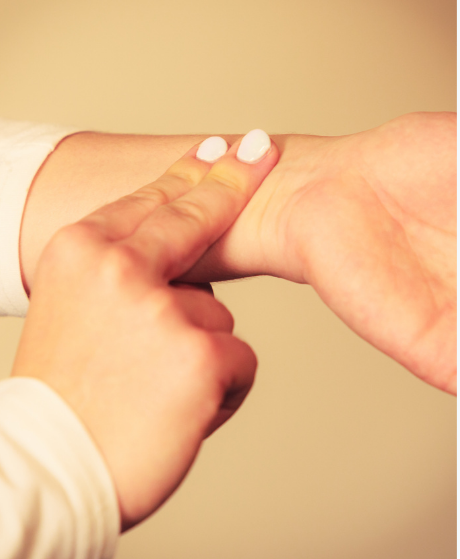1. Complete Activity 7.1 (Page 71). Place the middle and index finger of your right hand on the inner side of your left wrist. Can you feel some throbbing movements? Why do you think there is throbbing? Count the number of pulse beats in one minute. How many pulse beats could you count? The number of beats per minute is called the pulse rate. Find other places in your body where you can feel the pulse. Record your own pulse beats per minute and those of your classmates. Insert the values you obtained in Table 7.1 and copied them.
Answer:
The Activity 7.1 should be carried out in the following way:
Aim: To check your pulse rate at the wrist and find other places in your body where you can feel the pulse.
Materials Required: None
Procedure:
(i) Feel your pulse by placing the middle and index finger of your right hand on the inner side of your left wrist as shown the figure. Observe what you feel.
(ii) Count the number of pulse beats in one minute.
(iii) Find the other places in the body where the pulse can be felt.
(iv) Record your own pulse rate and those of your classmates and complete Table 7.1.

Observation:
When you put your fingers on your wrist you will feel throbbing movements. You will also observe that your and your classmates’ pulses beat anywhere between 72-80 times a minute. This is the pulse rate.
You will also observe that you can feel your pulse in the following regions of your body:
(i) On the side of the head above and in front of the ear.
(ii) On both sides of the neck.
(iii) On the inner side of the upper arm near on or near the elbow crease.
The pulse rates for yourself and your classmates can be recorded in Table 7.1 as shown:
Pulse Rate
| S. No. | Name | Pulse per minute |
| 1. | Ramesh | 72 |
| 2. | Riya | 75 |
| 3. | Sachin | 73 |
| 4. | Anisa | 74 |
| 5. | Self | 76 |
Conclusions:
You will find that the normal pulse rate for a person at rest should be around 72-80. If you exert yourself before you check your pulse, you will find that the pulse rate has increased. This is because during intense physical activity the heart pumps blood faster to meet the extra demand for oxygen. The pulse rate can be measured at other parts of the body (mentioned in the observation section) alongside your wrist.
“Complete Activity 7.1 (Page 71). Place the middle and index finger of your right hand on the inner side of your left wrist. Can you feel some throbbing movements? Why do you think there is throbbing? Count the number of pulse beats in one minute. How many pulse beats could you count? The number of beats per minute is called the pulse rate. Find other places in your body where you can feel the pulse. Record your own pulse beats per minute and those of your classmates. Insert the values you obtained in Table 7.1 and copied them.” – Solved.
Related Links:
Solution to Extended Learning Question 1
Solution to Extended Learning Question 2
Solution to Activity 7.2
Solution to Activity 7.3
Solution to Chapter 7 Transportation in Animals and Plants


